|
Week 12: October 17 - 23, 2012 |
Welcome
to the McGill Bird Observatory weekly report.
Click here for a complete listing of our archives.
Comments or
questions are welcome at "mbo AT migrationresearch.org".
|
PICTURE
OF THE WEEK: |
|
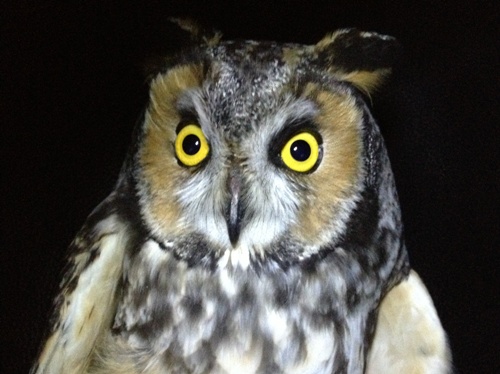
Generally we feature the owl highlights later in the weekly report. However, after
hearing Long-eared Owls regularly throughout all
our previous years of owling,
this week we managed our first capture of one - and a couple of hours later
banded a second one, making for a most memorable night!
(Photo by Simon Duval)
-
|
|
|
THIS WEEK |
THIS FALL |
2012 TOTAL |
SITE TOTAL |
|
# birds (and species) banded |
331 (28) |
3911 (83) |
5176 (88) |
40927 (108) |
|
# birds (and species) repeat |
82 (14) |
1030 (51) |
1368 (59) |
7781 (70) |
|
# birds (and species) return |
3 (3) |
78 (22) |
217 (29) |
1178 (38) |
|
# species observed |
69 |
143 |
163 |
207 |
|
# net hours |
454.0 |
6284.3 |
9544.1 |
68643.2 |
|
# birds banded / 100 net hours |
72.9 |
62.2 |
54.2 |
59.6 |
|
|
Note: table does not include nocturnal banding (owls) |
|
Banders-in-charge: Bob Barnhurst, Simon Duval, Gay Gruner
Assistants: Nicolas Bernier, Cindy Bouchard, Marine Dageville, David Davey, Jean Demers, Tammy Elliott, David Fishman, Alexandre Fouillet, Louise Gagné, Andray Gagné, Nathalie Gendron, Tiffany Gilchrist, Monique Groulx, Alison Hackney, Myriam Haineault, Frédéric Hareau, Lisa Keelty, Shelley Kirk, Marie-Pier Laplante, Barbara and Don MacDuff, Francine Marcoux, Betsy McFarlane, Genviève Potvin, Charles Régnier, Clémence Soulard, Rodger and Elise Titman
Notes: Many of the numbers for week 12 were similar to week 11, but it was one of the most exciting weeks of the season due to the many surprises that kept coming at us day after day. For the second-last week in the season, 331 birds banded is actually a very good total, the third highest we've had in our 8 fall seasons. More impressive though is the diversity - the 28 species banded this week is far ahead of the previous week 12 record of 23 species in 2010, and the long-term average of 19. The repeats kept up their season long trend of high numbers, breaking 1000 for a season for the first time. Returns are finally tapering off, but continuing to extend the new record even farther beyond the old peak of just 46 in fall 2007. Aside from a rain-shortened Friday morning, when only 34 species were recorded, the daily estimated totals were remarkably consistent this week, ranging only from 41 to 46 on the rest of the days, and adding up to a remarkable 69 species for the week - a full dozen more than our previous record for week 12, in both 2005 and 2008! Again, we thank our many volunteers who have been doing a great job taking notes on all the birds seen and heard every morning - as of the end of this week, our cumulative total of observations for the season is 77,777!
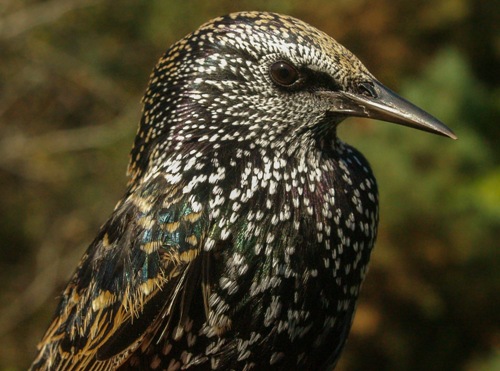
Had it not been for the surprises from our owling program, the European Starling above could well have been our bird of the week. As abundant as the species is overall, we band it only rarely at MBO - this was just our 12th overall, and our third as part of the Fall Migration Monitoring Program. Another good candidate would have been the Rusty Blackbird below, our 13th in 8 years of operation - though our second this fall, and amazingly, our sixth of the year ... 2012 has been good for them here!
(Photos by
Simon Duval)
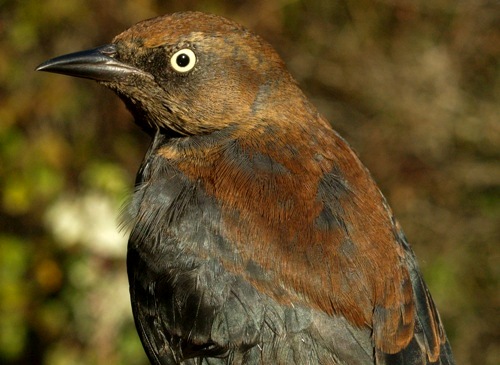
|
This week we observed our first Golden Eagle of 2012, as well as our first Greater Snow Geese and Bohemian Waxwings of the fall. The waxwings are more common at MBO in winter and early spring - this is only the fourth time in eight years that we've recorded them during the Fall Migration Monitoring Program. On the banding side, our only new species for the fall was European Starling. Among the American Robins this week was our first return of the year for that species, and also our first repeat (relatively uncommon for them).
This week’s top 10 [last week's rank in brackets]
# individuals banded |
mean # individuals observed daily |
1. Black-capped Chickadee (62) [9] |
1. Canada Goose (1159) [3] |
2. Slate-colored Junco (47) [3] |
2. Red-winged Blackbird (265) [2] |
3. American Robin (45) [5] |
3. American Robin (207) [4] |
4. Ruby-crowned Kinglet (41) [1] |
4. American Crow (130) [6] |
5. Fox Sparrow (25) [7] |
5. Common Grackle (80) [1] |
6. White-throated Sparrow (20) [2] |
6. European Starling (59) [5] |
7. Golden-crowned Kinglet (15) [9] |
7. Slate-colored Junco (44) [8] |
8. Hermit Thrush (14) [4] |
8. White-throated Sparrow (27) [7] |
9. American Tree Sparrow (12) [-] |
9. Black-capped Chickadee (25) [10] |
10. Red-winged Blackbird (10) [-]
|
10. Mallard (20) [-] |
|
A week after noting that this year's large Black-capped Chickadee migration appears to have largely by-passed MBO, we got a dose of it this week, with our fourth-highest single-week total of the species (behind only the final three weeks of fall 2010, which ranged from 87 to 139). This pushed the season total for Black-capped Chickadee to 145, the second best for fall in the past five years, but still behind the totals for 2005 and 2007, as well as 2010 of course. Close together for second and third place this week were Slate-colored Junco and American Robin, both routinely in the top three for week 12. Dropping down to fourth place from the top spot last week was Ruby-crowned Kinglet, with a season total to date of 349, the best since 2007. Perhaps the biggest surprise this week was Fox Sparrow, with 25 individuals banded, a single-week record at MBO. White-throated Sparrows are finally tapering off, but this week's 20 raised the season total to 496, putting them within striking distance of the best season ever for a sparrow (509 Slate-colored Juncos in fall 2010). Like their Ruby-crowned cousins, Golden-crowned Kinglets are also having a good fall, with 72 so far, on pace for their second best season ever. Meanwhile, although Hermit Thrushes began to drop off this week, the 14 birds we banded were enough to already push them to a new season record of 94. Rounding out this week's top ten were a modest count of American Tree Sparrows (they seem to be either scarce or late this fall), and a good (for fall) count of 10 Red-winged Blackbirds. The species dropping off from last week's top ten were Yellow-rumped Warbler, Purple Finch, and Song Sparrow.
The top six species observed this week remained the same, but shuffled positions a fair bit. After surprisingly low numbers for much of this fall, Canada Geese finally showed up en masse this week. On four days, the daily estimated total was above 1000 (peaking at more than 2300 on October 17), and even on the other three days we counted at least 500 daily. Well behind in second place was Red-winged Blackbird, which has been in the top three for week 12 annually since 2006. Not surprisingly, American Robin shifted up to third place this week - its streak of being in the top three at this time of year goes back one year farther, to 2005. In a feat of remarkable consistency, this marks the seventh time in eight years that American Crow ranked fourth in week 12 (in 2010 it was displaced one spot by an influx of European Starlings). Dropping down to fifth place this week was Common Grackle, perhaps finally tapering off after a remarkably dominant fall at MBO. This week's European Starling flocks also shrank a bit compared to what we've been seeing recently. Junco numbers remained steady this week, but thanks to a decline in White-throated Sparrows, the two species switched positions in the list. The influx of Black-capped Chickadees toward the end of the week gave them a slight boost, while Mallard flocks grew enough to squeak into the bottom of this week's top ten, displacing Ruby-crowned Kinglet from last week.
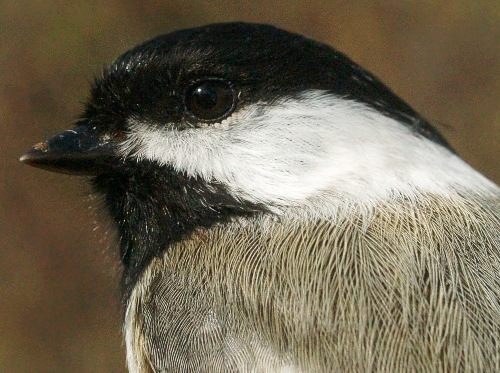
One of the 43 Black-capped Chickadees we banded on October 23 - the highest number of them we've ever had in a single day!
(Photo by
Simon Duval)
|
Last week ended with the busiest owl night of the season, and the next night was another good one, with 16 more Saw-whets ... plus our first ever Barred Owl! The next few evenings were a bit quieter by recent standards, with one rained out, and the other three ranging from 5 to 8 new owls. October 22 was another memorable night though, with the 18 Saw-whets almost eclipsed by not one, but two Long-eared Owls. Given that over six previous years of owling, we have only ever banded Northern Saw-whet Owls and Eastern Screech-Owls, adding two more species within one week is remarkable! We rounded out the week with another 20 Saw-whets on Tuesday night, making this the busiest week of the season with 73 Saw-whets plus the three other surprises (and now 213 Saw-whets for the season, already a record, and with two full weeks left in our standard monitoring period).
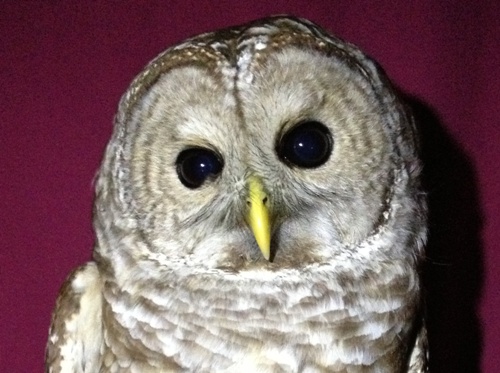
As if the Long-eared Owls weren't a big enough surprise this week, we also banded this Barred Owl - more of a surprise, as we have only occasionally heard this species at MBO while out at night.
(Photo by
Simon Duval) |
After a week like the one we've just enjoyed, it's a bit disappointing to realize that next week will mark the end of this year's Fall Migration Monitoring Program. Realistically, we will see diversity decrease a fair bit in that final week, but we're hoping some of our traditional late-season friends such as Northern Shrike will make an appearance before the season ends.
|
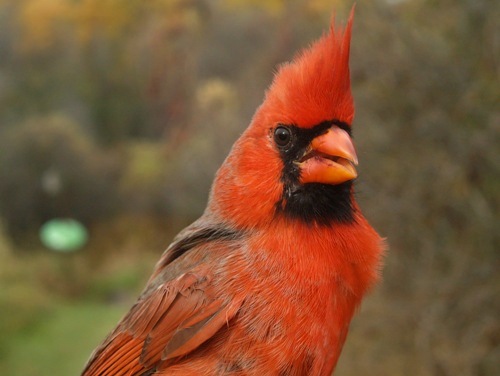
This week we recaptured the fully red male Northern Cardinal above. It's only because we banded it back in August (below) that we know it is actually a hatch-year bird, since its preformative moult was complete, as is often the case for this species. This also happened to be our busiest week ever for Northern Cardinals, with 6 banded, bringing the season total to a record high of 16.
(Photos by Simon Duval)
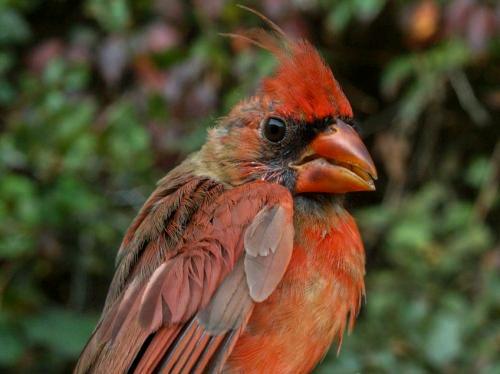
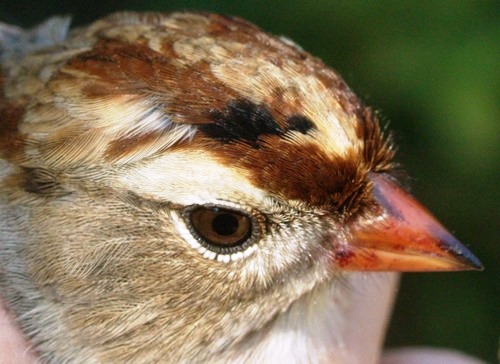
Also on the theme of moult this week, this hatch-year White-crowned Sparrow has already started to acquire some black feathers on its crown.
(Photo by Simon Duval)
|








